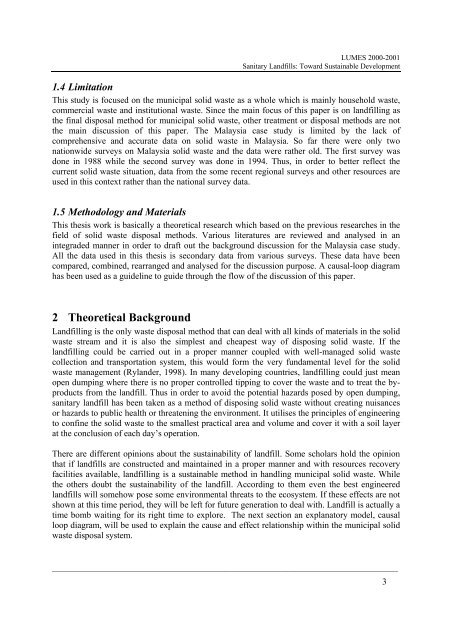Sanitary Landfills: Toward Sustainable Development - lumes
Sanitary Landfills: Toward Sustainable Development - lumes
Sanitary Landfills: Toward Sustainable Development - lumes
Create successful ePaper yourself
Turn your PDF publications into a flip-book with our unique Google optimized e-Paper software.
LUMES 2000-2001<br />
<strong>Sanitary</strong> <strong>Landfills</strong>: <strong>Toward</strong> <strong>Sustainable</strong> <strong>Development</strong><br />
1.4 Limitation<br />
This study is focused on the municipal solid waste as a whole which is mainly household waste,<br />
commercial waste and institutional waste. Since the main focus of this paper is on landfilling as<br />
the final disposal method for municipal solid waste, other treatment or disposal methods are not<br />
the main discussion of this paper. The Malaysia case study is limited by the lack of<br />
comprehensive and accurate data on solid waste in Malaysia. So far there were only two<br />
nationwide surveys on Malaysia solid waste and the data were rather old. The first survey was<br />
done in 1988 while the second survey was done in 1994. Thus, in order to better reflect the<br />
current solid waste situation, data from the some recent regional surveys and other resources are<br />
used in this context rather than the national survey data.<br />
1.5 Methodology and Materials<br />
This thesis work is basically a theoretical research which based on the previous researches in the<br />
field of solid waste disposal methods. Various literatures are reviewed and analysed in an<br />
integraded manner in order to draft out the background discussion for the Malaysia case study.<br />
All the data used in this thesis is secondary data from various surveys. These data have been<br />
compared, combined, rearranged and analysed for the discussion purpose. A causal-loop diagram<br />
has been used as a guideline to guide through the flow of the discussion of this paper.<br />
2 Theoretical Background<br />
Landfilling is the only waste disposal method that can deal with all kinds of materials in the solid<br />
waste stream and it is also the simplest and cheapest way of disposing solid waste. If the<br />
landfilling could be carried out in a proper manner coupled with well-managed solid waste<br />
collection and transportation system, this would form the very fundamental level for the solid<br />
waste management (Rylander, 1998). In many developing countries, landfilling could just mean<br />
open dumping where there is no proper controlled tipping to cover the waste and to treat the byproducts<br />
from the landfill. Thus in order to avoid the potential hazards posed by open dumping,<br />
sanitary landfill has been taken as a method of disposing solid waste without creating nuisances<br />
or hazards to public health or threatening the environment. It utilises the principles of engineering<br />
to confine the solid waste to the smallest practical area and volume and cover it with a soil layer<br />
at the conclusion of each day’s operation.<br />
There are different opinions about the sustainability of landfill. Some scholars hold the opinion<br />
that if landfills are constructed and maintained in a proper manner and with resources recovery<br />
facilities available, landfilling is a sustainable method in handling municipal solid waste. While<br />
the others doubt the sustainability of the landfill. According to them even the best engineered<br />
landfills will somehow pose some environmental threats to the ecosystem. If these effects are not<br />
shown at this time period, they will be left for future generation to deal with. Landfill is actually a<br />
time bomb waiting for its right time to explore. The next section an explanatory model, causal<br />
loop diagram, will be used to explain the cause and effect relationship within the municipal solid<br />
waste disposal system.<br />
______________________________________________________________________________<br />
3

















